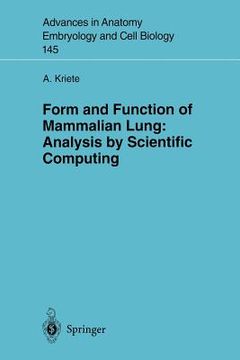Share
form and function of mammalian lung: analysis by scientific computing
Andres Kriete
(Author)
·
Springer
· Paperback
form and function of mammalian lung: analysis by scientific computing - Kriete, Andres
Choose the list to add your product or create one New List
✓ Product added successfully to the Wishlist.
Go to My Wishlists
Origin: U.S.A.
(Import costs included in the price)
It will be shipped from our warehouse between
Monday, June 03 and
Wednesday, June 19.
You will receive it anywhere in United Kingdom between 1 and 3 business days after shipment.
Synopsis "form and function of mammalian lung: analysis by scientific computing"
1.1 Overview The precise knowledge of the three-dimensional (3-D) assembly of biological structures is still in its origin. As an example, a widely accepted concept and common belief of the structure of the airway network oflung is that of a regular, dichotomous branching pattern, also known as the trumpet model. This model, first introduced by Weibel in 1963, is often used in clinical and physiological applications. However, if this concept of dichotomy is used to model lung, a shape is obtained that is quite different from a real lung. As a matter of fact, many previous quantitative morphological and stereological investigations of lung did not concentrate on the spatial aspect of lung morphology but delivered data in a more statistical fashion. Accordingly, the functional behavior predicted by such a model becomes questionable and indeed, the morphometrically predicted lung capacity exceeds the physiological required capacity by a factor of 1.3 up to a factor of2. This problem has also been termed a paradox, as discussed by Weibel in 1983. In the rare cases where descriptive models of the mammalian bronchial tree exist, monopodial in small mammals, dichotomous in larger ones, the understanding of the historical and/or functional reasons for size-related changes in the general design is not explainable. This investigation is trying to overcome this gap by computer modeling and functional simulation.
- 0% (0)
- 0% (0)
- 0% (0)
- 0% (0)
- 0% (0)
All books in our catalog are Original.
The book is written in English.
The binding of this edition is Paperback.
✓ Producto agregado correctamente al carro, Ir a Pagar.

